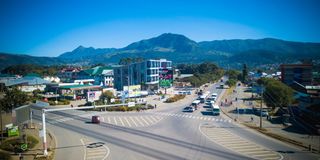Prime
Tanga, Mbeya face investment disconnect despite potential

Mbeya
What you need to know:
- In 2024, Mbeya attracted only 20 registered projects, valued at $59.22 million, and created 2,442 jobs. Tanga, on the other hand, recorded 23 projects worth $137.66 million, generating 1,315 jobs.
Dar es Salaam. Despite ranking among the top six cities in Tanzania by economic output, Mbeya and Tanga are lagging significantly in attracting investment projects, capital, and jobs, casting a spotlight on the growing disconnect between GDP performance and investment facilitation at regional levels.
According to the Bank of Tanzania’s Zonal Economic Performance Report for the third quarter of 2024, Mbeya was ranked third overall, with a per capita GDP of Sh4.3 trillion. Meanwhile, Tanga part of the Northern Zone, was 10th with Sh3.2 trillion.
However, investment data from the Tanzania Investment Centre (TIC) paints a contrasting picture.
In 2024, Mbeya attracted only 20 registered projects, valued at $59.22 million, and created 2,442 jobs. Tanga, on the other hand, recorded 23 projects worth $137.66 million, generating 1,315 jobs.
These figures contrast sharply with the performance of cities with comparable or even lower GDP rankings.
Dar es Salaam led the country with 356 projects, over 107,000 jobs, and more than $4.4 billion in capital investment. Mwanza, which ranks second in GDP, registered 37 projects valued at $581 million. Arusha drew 64 projects and $213 million in capital, driven largely by tourism and trade.
Dodoma has capitalised on government-led infrastructure and industrial schemes. Located in the Central Zone, it boasts high levels of electricity supply, significant livestock production contributing 29 percent of the national value, as well as strong manufacturing and administrative services.
Even regions such as Ruvuma and Shinyanga, which fall outside the top six in economic output, secured capital of $597.64 million and $415.21 million respectively, from fewer projects.
Economists attribute Mbeya and Tanga’s underperformance to a combination of institutional silence, fragmented investment planning, and weak promotional strategies.
Speaking with The Citizen, yesterday, an economist at the University of Dar es Salaam, Dr Tobias Swai, said that while the two cities have strong economic foundations, they are largely absent in Tanzania’s broader investment narrative.
He explained that GDP alone does not attract investors unless it is supported by targeted and sustained visibility.
“Mbeya and Tanga are productive economies, but they remain off the radar because there is no deliberate strategy to position them as investment-ready cities,” he noted.
For his part, an economist from the University of Dodoma, Dr Mwinuka Lutengano, pointed out that both cities have untapped strategic advantages.
He said Mbeya’s proximity to SADC markets and its agricultural base, and Tanga’s port infrastructure and pipeline connections, should make them front-runners.
However, these advantages, she argued, have not been effectively marketed to investors.
“These cities should be competing at the top, but without proper promotion and facilitation, their assets go unnoticed,” he shared.
An economist from Udsm, Dr Emmanuel Maliti, reinforced the notion that investors prioritise a conducive operating environment over macroeconomic size.
He observed that regions like Pwani and Arusha have built systems to reduce bureaucratic delays, offer land readiness, and support post-investment services.
In contrast, he said, Mbeya and Tanga have weak investor touchpoints, leaving interested firms to navigate processes with little local support.
“It’s not just about the numbers—it’s about readiness. Mbeya and Tanga are still catching up in that regard,” he remarked.
On top of that, the Executive Director of the Research on Poverty Alleviation (Repoa), Dr Donald Mmari said that the part of the challenge is poor alignment with national investment priorities.
While the government continues to promote industrialisation, she said some regional authorities are yet to adapt their local strategies accordingly.
“Regions like Dodoma and Pwani have positioned themselves clearly within national industrial plans. Mbeya and Tanga still treat investment as a secondary priority,” he commented.
Another economist, Dr Isack Safari from Saint Augustine University of Tanzania (SAUT) pointed to the absence of a compelling regional investment brand.
He noted that investors are increasingly drawn to areas with a defined economic identity and a proactive approach to facilitation.
“Mbeya and Tanga have the fundamentals but no cohesive narrative. Their story hasn’t been told—certainly not to the right audience,” he said.
Meanwhile, other regions continue to gain ground. Pwani registered 166 projects worth $1.24 billion, creating nearly 50,000 jobs.
Even Morogoro, with 22 projects, outpaced Mbeya and Tanga in both job creation and capital, registering over 11,000 jobs and $446 million in investments.





